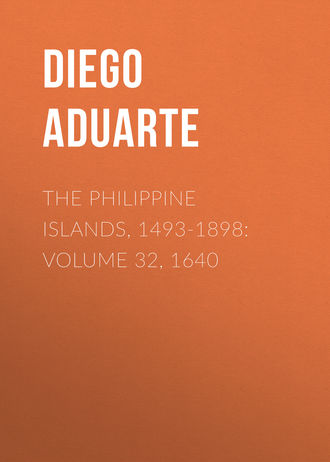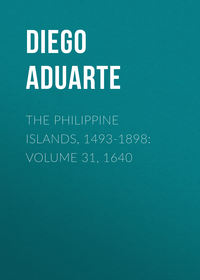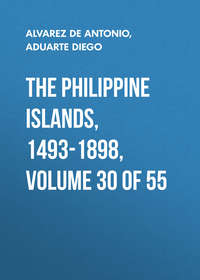 полная версия
полная версияThe Philippine Islands, 1493-1898: Volume 32, 1640
Alluding to the cathedral El Pilar at Zaragoza, in which is a famous statue of the Virgin descending upon a pillar. It soon became a rival of the noted shrine of St. James at Compostella, in the number of pilgrims attracted thither, and miracles performed. Maria del Pilar is a favorite name for girls in Spain, commonly abbreviated to Pilar.
63
Carlos Clemente Gant made his profession at Zaragoza, in 1602. He came to Manila in 1611, and spent most of his life in the Cagayán missions, filling many high offices in that region; he was also provincial for two terms. He died at Lal-ló, in 1660, at the age of seventy-two.
64
Luis Oñate made his profession at Sevilla, in 1626, and came to the islands in 1632. He spent the rest of his life in the Cagayán missions; and he died at Manila on June 18, 1678, at the age of almost seventy.
65
Juan Bautista Morales was born in 1597, at Ecija; he entered the Dominican convent there, but was ordained in Mexico. In 1618 he came to Manila, and was assigned to the ministry among the Chinese there. In 1628 and 1629 he was in Camboja, but was unable to establish a mission there. In 1633 he went to China; after spending several years in the missions there, he was sent (1640) by his order to Europe, to make complaint regarding the practice of the “Chinese rites” by the Jesuits in China. Taking the overland route from Goa, Morales arrived in Italy in January, 1643; five years later, he escorted a band of missionaries to Manila, and in 1649 returned to China. He spent the rest of his life there, dying at Fo-Kien, September 17, 1664. (See Reseña biográfica, i, pp. 358–369.)
66
Francisco Diaz was born near Valladolid, October 4, 1606, and entered the Dominican order there. Coming to Manila in 1632, he spent some time in the Chinese hospital; and in 1635 he entered the China mission, where he spent the rest of his life, dying at Ting-teu, November 4, 1646. (See Reseña biográfica, i, pp. 393–411.)
67
Referring to the Chinese moralist and teacher Kôshi, usually known to Europeans as Confucius. His teachings have exercised a powerful influence on the history and national character of Japan; and Iyeyasu’s celebrated code of laws was modeled thereon.
68
Mateo de la Villa, born in the province of Oviedo, made his profession in the Dominican convent at Salamanca, in 1600. Six years later he came to the islands, where he spent many years in the Cagayán missions. In 1622 he was appointed procurator at Madrid and Rome, a charge which he held as late as 1665; but it is not known when and where he died. (See Reseña biográfica, i, p. 330.)
69
This was Fray Diego Collado, who had come to the Philippines in 1611; see sketch of his life in Vol. XXV, p. 158. The band whom he led were called “Barbones” (see Vol. XXV, p. 161).
70
Allusion is here made to the famous town of Santiago de Compostela, formerly the capital of Galicia. Its foundation was due to the alleged discovery (in the ninth Century) of the burial place of St. James the apostle, who afterward became the patron saint of Spain. A church was built over the tomb of the saint, by Alfonso I, but was destroyed by the Saracens; the present cathedral was begun about 1080. It soon became a noted resort of pilgrims, being visited by many thousands every year, and has continued to be such to the present time.
71
Referring to Fray Francisco de Zamudio, an Augustinian, the bishop of Nueva Caçeres – of whom bare mention (and that only as a confessor) is made in Pérez’s Catálogo. Cf. the earlier controversy on this question between Archbishop Serrano and the religious orders (1624), for which see Vol. XXI, pp. 32–78.
72
The Japanese was named Lazaro; he was one of the lepers who had been formerly exiled from Japan for the faith, and came with the Dominicans as a guide. Although at first he denied the Christian faith, under pressure of torture, he afterward recovered courage, and died as a martyr, September 29, 1637. The mestizo was Lorenzo Ruiz, a native of Binondo; he had left Luzón on account of a murder that he had committed there. He also was martyred, at the same time as Lazaro. (See Reseña biográfica, i, p. 276, note.)
73
Biographical sketches of all these martyrs are given in Reseña biográfica, i, pp. 258–276.
It is well to note, in this connection, the fact that the persecutions of Christians in Japan were not, in the main, on religious grounds. The Japanese government was tolerant to the new religion until it had reason to fear that its authority was being subverted by the influence of the missionaries, and the independence of the nation threatened by the foreign nations who sent to Japan the priests and traders. See Griffis’s Mikado’s Empire, pp. 247–259, Rein’s Japan, pp. 290–293, and Murdoch and Yamagata’s History of Japan, pp. 457–506. The last-named cites at length the writings of Charlevoix, Léon Pagés, and other historians.



